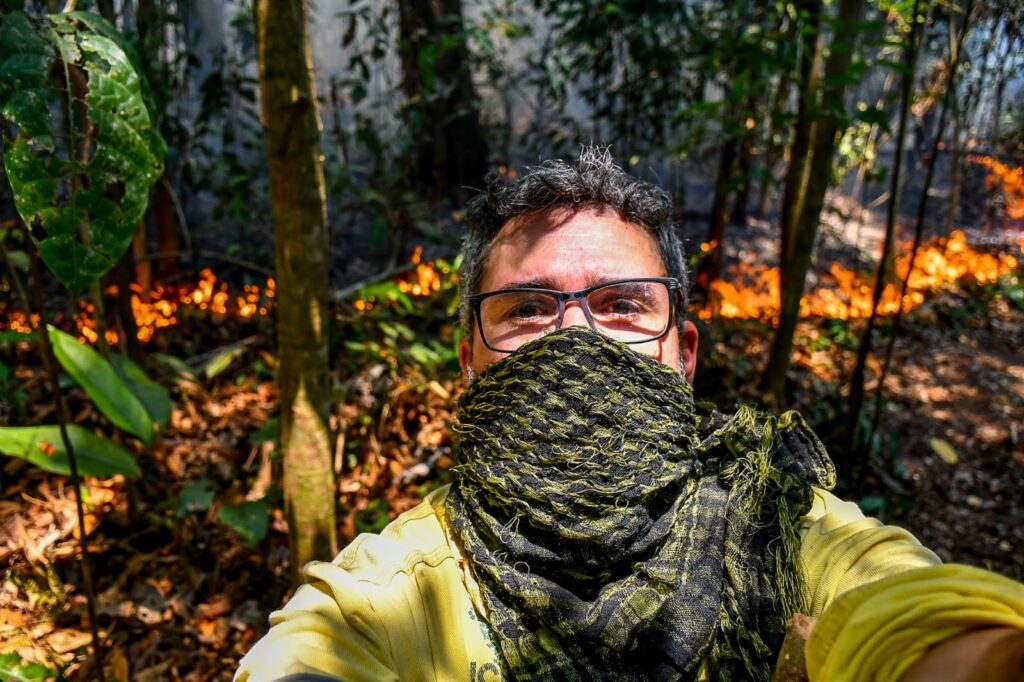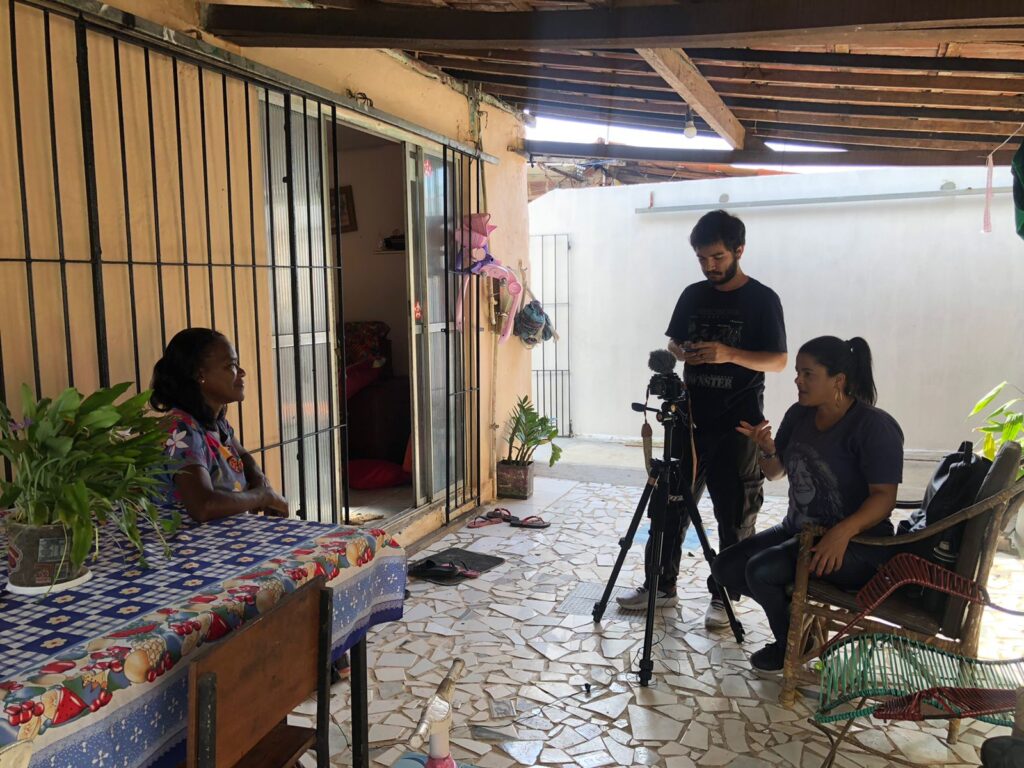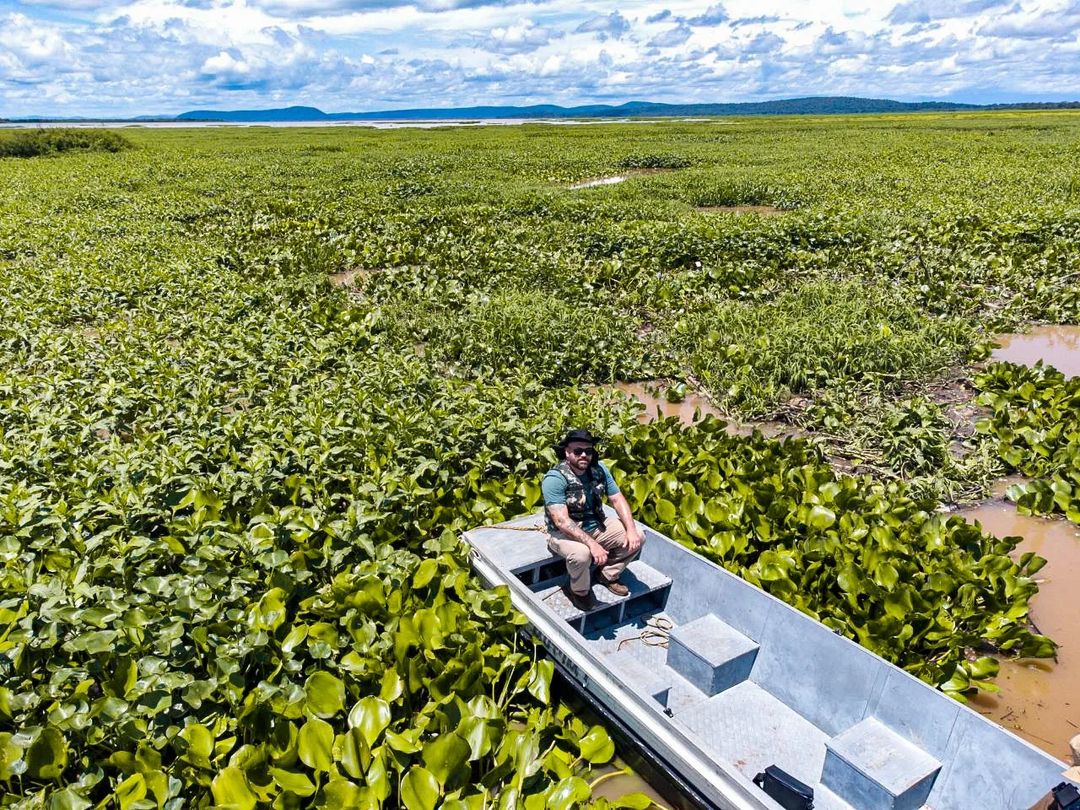João Paulo Guimarães was 39 years old when, for the first time, his photo of an ocelot killed during the 2020 fires in the Pantana attracted a lot of attention.
A resident of Belém in northern Brazil, he had traveled about 1,800 miles away to the Pantanal, the world’s largest wetland, paying his own way. Once there, he realized his work could have an impact.
"It was the first time I experienced one of my images going much further than I expected," Guimarães told LatAm Journalism Review (LJR). "I wasn't looking to be famous, rather relevant."
In the following years, Guimarães intensified his coverage of socio-environmental and human rights issues, also starting to write in addition to photographing. His work has gained recognition, and he routinely collaborates with outlets such as UOL, Repórter Brasil, Agência Pública, The Intercept Brasil and Mongabay. Despite the success, he sometimes still pays for materials out of his own pocket.
"You can make a living, benefit from grants and projects, but there's no money left to have a house," he said about the precariousness of the profession. “I live with my father-in-law and mother-in-law. If it weren’t for this, it wouldn’t be possible.”
On Dec. 14 Guimarães will release his first book, “O Caçador de Trolls - monstros sociais pelas lentes de um fotojornalista” (The Troll Hunter - social monsters through the lens of a photojournalist). In the book, enriched with various photographs, the journalist talks about his professional routine and the dilemmas he faces while bringing attention to often overlooked stories, such as those of threatened Indigenous communities, children surviving by collecting trash, and community leaders who have been murdered. He seeks to share these stories with the world and to change something. Between narrations of his coverage, including a strong focus on topics linked to Indigenous issues, the journalist talks about his personal concerns: the lack of money, the precariousness of traveling without a large organization behind him, endless hours of travel, the threats he suffers.

João Paulo Guimarães documenting the efforts of the Ka'apor Indigenous people to combat wildfires in the Alto Turiaçu Indigenous Land in Maranhão. (Photo: João Paulo Guimarães)
Guimarães' story is similar to that of many freelance reporters covering topics related to social and environmental justice in Brazil. Driven by a strong sense of mission, these professionals are faced with adversities ranging from little remuneration to a lack of interest from large media outlets to recurring threats from actors singled out in reporting. Despite insisting on not giving up, they refer to a broader trend: it is increasingly difficult to produce meaningful reporting in Brazil, especially when defending the most vulnerable.
Adriana Amâncio, 44, has worked exclusively as a freelance journalist since 2022. She gets by as best as she can: she tries to write at least two strong articles per month, and the rest of the time she dedicates herself to selling hard news.
“Experiencing the speed of hard news without a newsroom structure is hell. I pitch and pitch. I offer stories that will end up in every type of section,” Amâncio told LJR.
Her real interest, however, is in investigative journalism, especially in topics related to human rights, gender and socio-environmental issues. One of her favorite texts appeared at the end of October on the environmental journalism site Mongabay: Amâncio reported that a genetically modified cotton crop was planted in an exclusion zone for five years in the state of Mato Grosso, openly violating an official biosafety standard.
In collaboration with colleagues, including a journalist who carried out geoprocessing analysis and co-author André Uzêda, Amâncio reported that a farm in the municipality of Marcelândia owned by a megaproducer disregarded a GMO exclusion zone, created with the aim of avoiding contamination of native cotton, a natural seed used in family farming by Indigenous and Quilombola communities.
“In the middle of the interview, when I started to put my finger on the wound, the [cotton producer] said he did not authorize the publication. He could no longer withdraw from the interview, but that did not take away his right to sue me,” Amâncio said. “Money plays a big role in the way we access legal benefits.”
According to Amâncio, due to suspicions of internal leaks, the National Technical Commission of Biosafety (CTNBio, for its acronym in Portuguese) even launched an internal investigation to understand how she obtained some documents, but she managed to prove she obtained them all via the Access to Information Law.
“I proved that everything was done legally,” Amâncio said. “This episode showed me the vulnerability of being a freelancer, of dealing with threats and intimidation.”

Journalist Adriana Amâncio reporting for the story "Caminhos da Alimentação," published by Gênero e Número. (Photo: Courtesy)
Vulnerability to lawsuits and threats to physical integrity are among the most common problems reported by those covering these topics. Large media outlets have permanent legal teams. Internationally, there are services that offer security advice for journalists. When the contract is for just one or a few stories, however, reporters' feelings of helplessness and uncertainty are much greater.
“Many media outlets have headquarters and editors in other states, but I’m here in Recife,” Amâncio said. “I don’t know how I, a freelancer and mother, could face such powerful people as the ones I expose in my work.”
She cites the lack of financial security as her greatest fear. She says she worked as a press officer, but earned about US $490 a month for a large volume of work.
“The environment was also very pragmatic, very corporate. I need to do journalism that minimally contributes to a better world,” Amâncio said.
After participating in three panels at the Abraji Congress in July, including one on how to work as a freelance journalist, Amâncio said she made some contacts, and that in recent months more job proposals have appeared. When she can't get enough work, she shares the household bills with her 23- and 24-year-old children, both of whom are students and interns.
“In the months when the bills don’t add up, one pays for electricity, the other for the internet,” Amâncio said.
Reporting grants, often funded by international outlets and non-profit organizations, are regularly cited by freelancers working on human rights issues as a pillar of financial support. Reporter Leandro Barbosa, who has an extensive career, uses them frequently. He notes, however, a limitation of these kinds of resources: an almost exclusive interest in the Amazon, to the neglect of other areas.
“The calls for proposals are focused on a single topic, the Amazon; It’s important, of course, but this ends up making it impossible to cover other topics,” Barbosa told LJR. “We have no calls for the Cerrado, the Caatinga or the Atlantic Forest [other Brazilian biomes], nor any interest from newsrooms.”
Barbosa, who recently won the Gabo Award in the Coverage category for being a member of the InfoAmazonia team that produced the Amazon Underworld project, has adopted alternative strategies to produce the stories that interest him, with a special focus on extreme weather events and land issues. One of them is to travel boldly and courageously with your own resources. He says that once in the field, it's easier to find interest from publications.

Journalist Leandro Barbosa in the Chacororé Bay, in the Pantanal, Barão do Melgaço/MT. (Photo: Gabriel Schlickmann)
Another strategy, more frequently adopted at the beginning of a career, is the use of crowdfunding campaigns. This is how he supported himself when he was just starting out in 2016 with coverage of the Mariana dam disaster.
“Most of my coverage until 2020 and 2021 was made possible by crowdfunders on social media,” he said. “In 2020, when I covered the fires in the Pantanal, my work had more than 17 million views on social media. This guaranteed a fund of R$50,000 (about US $8,200) the following year, to build the team and get the work done.”
The journalist said that, when he needed legal support, he found it from the Brazilian Association of Investigative Journalism (Abraji) and from the media outlets that published his work. Barbosa said that he has tried to secure fixed contracts with media outlets, but never gets the position.
Interviewers wonder how he would adapt to the routine of a newsroom, he said.
“Even though I won an award, I realize that sometimes questions arise like ‘how will you feel in the newsroom, without all this freedom,’” he said.
The problems faced by journalists in Brazil are not exclusive to the country. According to UNESCO, which carried out a survey of 900 professionals in 129 countries, 70% of journalists covering the environment have suffered attacks or threats for their work. The organization has recorded 44 murders of journalists working on the subject over the past 15 years, which have resulted in just five convictions.
Faced with so many difficulties, the question that remains is why professionals insist on reporting on issues related to human and environmental rights.
The most common responses are a sense of collective purpose, with work that benefits others. João Paulo Guimarães cites as an example the first story he wrote for The Intercept Brasil, about illegal extraction of pebbles in the Mojú River, in Pará. Three days after the article was published, those accused of the crimes were arrested, he said.
“It’s not just a job, but also a battle to bring the facts to light, to draw attention to the problems,” Guimarães said.
Leandro Barbosa said that, even before becoming a journalist, he worked in social organizations. The profession and his love of storytelling combined with his previous political interest, as a way of enhancing it.
“But it’s not always a bed of roses. In therapy, I sometimes say that I don’t know if I want to continue as I am,” he said.
Adriana Amâncio cited the impact of her articles as one of her motivations. She recalled an article she wrote telling the story of a sick elderly woman who walked seven miles a day to get water. After the publication, readers came together and bought a cistern for the woman. Amâncio's goal, she said, is to generate this kind of impact, one article at a time.
“Capitalism tells us that the American dream is everyone’s dream, to have a house and a car,” she said. “But my Latin American dream is to be able to do journalism that makes a difference in people’s lives.”